Les cloches de Corneville
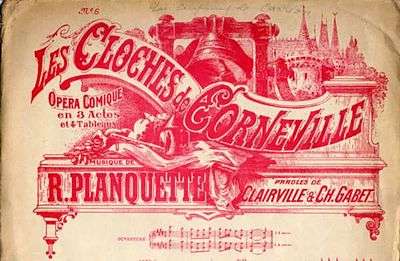
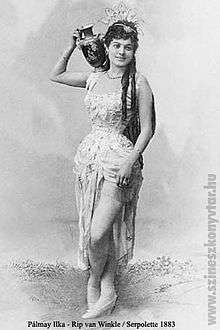
Les cloches de Corneville (known in English as The Chimes of Normandy or The Bells of Corneville) is an opera-comique in three acts, composed by Robert Planquette to a French libretto by Louis Clairville and Charles Gabet based on a play by Gabet.
In 1876, the director of the Théâtre des Folies-Dramatiques, Louis Cantin, hired Planquette to compose the operetta, which had originally been intended for Hervé.[1] Despite initially mixed reviews (the storyline was criticized for its similarity to La dame blanche and Martha), it became probably the most popular French operetta of all time, with hit productions in London and elsewhere. Les cloches de Corneville was Planquette's first full operetta score and has been praised for its fine melodies, rhythmic variety, good choral writing and complex orchestral colour (although Planquette may not have done the orchestration himself).[2]
Performance history
Les cloches de Corneville was first produced in Paris at the Théâtre des Folies-Dramatiques, opening on April 19, 1877, and ran for 408 performances.
The operetta was then produced as The Chimes of Normandy at the Fifth Avenue Theatre in New York City, beginning on October 22, 1877. There was also another New York run in 1878. Later productions included one as The Bells of Corneville at the Victoria Theatre in New York, beginning on April 21, 1902.
In London, it played at the Folly Theatre, with an English libretto by H. B. Farnie and Robert Reece, opening on February 28, 1878 (transferring to the Globe Theatre on 31 August 1878 as The Chimes of Normandy), outlasting H.M.S. Pinafore by running for a world record-setting 705 performances (holding this record until Dorothy in 1886).[3] Violet Cameron and Shiel Barry starred as Germaine and Gaspard. At the same time, the production toured the provinces, starring Florence St. John as Germaine, who then joined the London cast late in the run, making her West End debut.
The work remained popular thereafter; it was translated into several languages and enjoyed numerous productions worldwide.[4] In 1917 it was adapted in Britain as a silent feature film, under its French name, directed by Thomas Bentley. It continued to be performed into the 1940s in Britain[2] and the 1960s in France,[4] and it still receives some productions today.[5]
Roles and role creators
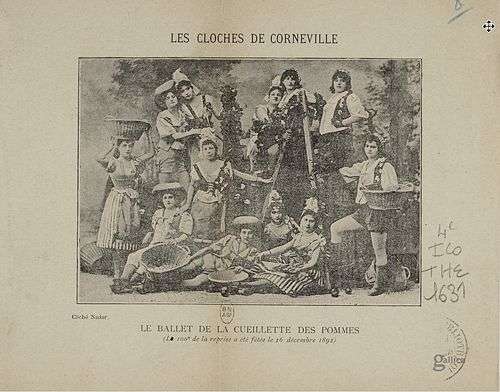
| Role | Voice type |
Premiere Cast, 19 April 1877 (Conductor:) |
|---|---|---|
| Serpolette, the good-for-nothing | soprano | Juliette Simon-Girard |
| Germaine, the lost Marchioness | soprano | Conchita Gélabert |
| Henri, the Marquis of Corneville | tenor | Ernest Vois |
| Jean Grenicheux, a fisherman | tenor | Simon-Max |
| Gaspard, a miser | baritone | Ange Milher |
| The bailiff | baritone | François-Louis Luco |
| Gertrude | ||
| Jeanne, Manette and Suzanne, belles of Corneville | ||
| Registrar, Assessor, Notary | ||
| Villagers and attendants of the Marquis | ||
Synopsis
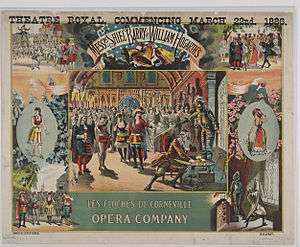
- Act I - Scene I - A wooded trail near Castle Corneville
The miserly old farmer Gaspard is despised in the village of Corneville for his cruel treatment of his niece, Germaine. He wants to force her to marry the elderly sheriff, because the sheriff has become suspicious of Gaspard and threatens to investigate his suspicions. But Germaine feels obligated to Jean Grenicheux, an aristocratic young fisherman, who claims that he once rescued her from drowning. Gaspard has a maid named Serpolette, whom he found as a child abandoned in a field. She has grown into a pert beauty and is the object of gossip by the local women, who call her good-for-nothing. She too is enamored of Grenicheux.
A stranger dressed as a sea captain arrives, whom Germaine attempts to turn away from the castle, saying it is haunted and telling him that the castle's bells will only ring again when the rightful master returns. The stranger is actually Henri, the Marquis de Corneville (just returned from exile), who recalls his childhood and a young girl who fell into the sea. He pulled her out and never saw her again. He has come to retake his castle and fields.
- Act I - Scene II - The market of Corneville
At the market, twice a year, one can hire domestic servants or coachmen. Germaine, Serpolette and Grenicheux all engage themselves to the mysterious Henri, hoping to escape the sordid plans of old Gaspard.
- Act II - A large hall in Castle Corneville
Marquis Henri brings his new employees to the castle at night and reveals his true identity. He tries to reassure them about the ghosts. He has resolved to restore his immense castle, which was badly neglected in his absence. He discovers a letter in the castle stating that the infant Vicomtesse de Lucenay was at one time in danger and so was entrusted to Gaspard to be brought up under a false name. Everyone thinks this must refer to Serpolette. Henri also finds himself becoming attracted to Germaine. She tells him the story about how Grenicheux saved her, and how she feels obligated to marry him. Henri realizes that Germaine is the girl that he himself had rescued and that Grenicheux’s claims to have done so are false.
Meanwhile, old Gaspard had purposely fostered rumors that the cellars of the castle are haunted, because he has hidden treasures of his former masters there. He arrives at night in a boat to visit his gold, thinking the castle is empty. Henry and the others, clad in suits of armor, jump out, ring the bells of the castle and capture the old trickster. The shock drives the old man mad.
- Act III - The grounds of Castle Corneville
After the renovation of the castle and the ringing of the bells, Henri is recognized as the rightful master of the Castle of Corneville. He gives a feast for the whole village, and his guests rejoice. Gaspard, who has lost his reason, wanders from group to group, singing. Serpolette is assumed to be the Vicomtesse of Lucenay, because the page from the birth register of the village (noting the births of Serpolette and Germaine) has disappeared (Gaspard had stolen it). Grenicheux has become factotum to the Vicomtesse Serpolette and is now courting her.
Henri has fallen in love with Germaine, although she is only a servant in his household. He orders Grenicheux to confess his deception, but not to reveal the name of the actual rescuer. Germaine overhears their conversation. Henri asks Germaine to be his wife, but she demurs, believing that a servant cannot marry a Marquis. Gaspard, recovering his senses, remorsefully declares that his pretended niece is the rightful Vicomtesse de Lucenay (and Serpolette only a gypsy orphan), and so the Marquis may wed Germaine. Henri forgives Gaspard, Serpolette takes Grenicheux, and all ends happily, as the bells of Corneville are set ringing.
Musical numbers (original French version)
- Act I
- Ouverture
- Scene 1
- 1. Chœur, Chanson des on-dit: "On dit, on dit, charmante femme"
- 2. Rondeau de Serpolette "Dans ma mystérieuse histoire"
- 3. Chanson du mousse (Grenicheux)
- 4. Duo (Germaine et Grenicheux) "Même sans consulter mon coeur"
- 5. Légende des cloches "Nous avons hélas perdu d'excellents maîtres" (Germaine et Chœur)
- 6. Rondeau-valse "J'ai fait trois fois le tour du monde" (Henri)
- 7. Ensemble "A la perruque d'un bailli"
- Scene 2
- Entr'acte
- 8. Couplets de Grenicheux "Je ne sais comment faire";
- 9. Final de l'acte I: Scene du marche, choeur des servantes, des domestiques.
- Act II
- 10. Chœur "À la lueur de ces flambeaux"
- 10b. Air de Germaine: "Ne parlez pas de mon courage"
- 10c. Chanson du Serpolette
- 11. Chanson du Bailli: "J'avais perdu la tête"
- 12. Chanson d'Henri et choeur: "Sous des armures à leurs tailles"
- 13. Ensemble et couplets "Vicomtesse et Marquise" (Serpolette, Henri, chœurs)
- 14. Duo Germaine-Henri "C'est elle et son destin"
- 15. Chœur et quintette "Gloire au valeureux Grenicheux"
- 16. "C'est là, c’est là qu'est la richesse" (Gaspard, Grenicheux) et final II.
- Act III
- 16a. Entr'acte et danse
- 17. Chanson des gueux (Gaspard)
- 18. Chœur et chanson: "R’gardez par-ci r'gardez par-là" (Serpolette, Grenicheux)
- 19. Chanson du cidre, Serpolette et choeur: "Vive le cidre de Normandie"
- 20. Rondeau-valse de Grenicheux: "Je regardais en l'air"
- 21. Duo Germaine-Henri "Une servante, que m'importe"
- 22. Final de l'acte III
Musical numbers (English adaptation)
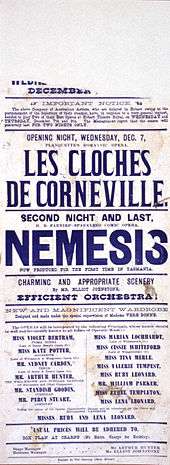
- Overture
- Act I - Scene 1 - A forest near the village of Corneville.
- No. 1 - Chorus - "All who for servants are enquiring, just look at us if you'd be hiring"
- No. 2 - Serpolette - "I may be Princess, leastways Madam, that from my style at once is seen"
- No. 3 - Grenicheux - "On billow rocking, at tempest mocking, gallant sailor boy, ocean's thy home"
- No. 4 - Germaine and Grenicheux - "'Twas but an impulse, that I own, (and wrong perhaps the troth then spoken)"
- No. 5 - Legend of the Bells - Germaine and Chorus - "Yes! that castle old by wizard is enchanted"
- No. 6 - Henri - "With joy my heart has often bounded, when one plank parted death and me"
- No. 7 - Finale - "Such conduct is quite sad, and in one about to marry"
- Act I - Scene 2 - The Fair of Corneville.
- Entr'acte
- No. 8 - Grenicheux - "Tho' they may not pursue me, this quarrel will undo me"
- No. 9a - Finale (first part) - "Come! farmer small or with big rental, if first class servants you would find"
- No. 9b - Finale (conclusion after dialogue) - "Tell me, girl, what may be your name?"
- Act II - A Hall in the Chateau of Corneville.
- No. 10 - Entr'Acte and Chorus - "Let our torches light up the gloom"
- No. 10bis - Germaine - "From pallid cheek you may be telling, with fear, not courage, now I thrill"
- No. 10c - Serpolette, with Grenicheux and Bailli - "I'll shut my eyes" & "Not a ghost at all!"
- No. 11 - Le Bailli - "Oh dear! That riot and that rabble, never was Bailli so beset before!"
- No. 12 - Henri and Chorus - "Nay! no phantom they knights of old, my ancestors their leal watch silent keeping"
- No. 13 - Serpolette and Ensemble - "What's she saying? ... 'Twas I, 'twas I, these papers cannot lie!"
- No. 14 - Henri and Germaine - "'Tis she! A happy fate hath brought her to me, who all in vain had sought her!"
- No. 15 - Chorus and Quintette - "As he's looking somewhat pale, put, oh, put him into mail!"
- No. 16 - Finale - "Love, honor, happiness, moon of honey, what are they all compar'd to gold?"
- Act III - A Park, with a statue and shrubbery.
- No. 16a - Entr'acte and Dance
- No. 17 - Song of the Beggars - Gaspard - "Aye, aye, aye! the good old times have come back again"
- No. 18 - Chorus and Song - Serpolette and Grenicheux - "There she goes, with horses prancing!"
- No. 19 - Cider Song - Serpolette and Chorus - "Normandy pippin's good all over; where is the girl wont have a slice?"
- No. 20 - Grenicheux - "That night I'll ne'er forget, in the late sun ray glowing"
- No. 21 - Germaine and Henri - "My lord, my lord! My silly heart is beating, for oh! I feel I am your thrall!"
- No. 22 - Finale - "Old man! I pardon thee with greatest pleasure, if thou didst finger and hoard up my gold"
- Supplementary Item
- No. 23 - "There's magic music in my bosom beating"
First sound film
The first historical experiment in synchronizing sound and motion pictures in 1894 featured one of the songs from the operetta. "The Song of the Cabin Boy," (Chanson du mousse), the barcarolle (No. 3), was played on the violin by William Kennedy Laurie Dickson. It may be viewed online as The Dickson Experimental Sound Film.[6]
Selected recordings
- 1973/2002
- Orchestre du Théâtre National de L'Opéra-Comique
- Conductor: Jean Doussard
- Principal singers: Mady Mesplé (Germaine), Bernard Sinclair (Henri), Charles Burles (Grenicheux), Christiane Stutzmann (Serpolette), Jean Giraudeau (bailiff), and Jean-Christophe Benoît (Gaspard).
- Recording date: June 1973 and released on LP by EMI;[2] Released on CD August 5, 2002
- Label: Angel Records - B00005A9OA (CD)
- 1955
- Orchestra and Chorus
- Conductor: Pierre Dervaux
- Principal singers: Huguette Boulangeot (Germaine), Ernest Blanc (Henri); Jean Giraudeau (Grenicheux); Colette Riedinger (Serpolette), André Balbon (bailiff) and Louis Musy (Gaspard).
- Recorded at Universal (Decca) Studios, Antony, France 1955
- Mono (2-CD set) Discovery/Accord Operette Series 465 861-2[7]
Score and libretto
- English Vocal Score (Boston: Oliver Ditson, 1879) From Sibley Music Library Digital Scores Collection
- English Libretto (New York: Tretbar, 1870) From Sibley Music Library Digital Scores Collection
Notes
- ↑ Gänzl, Kurt: Les cloches de Corneville, Grove Music Online, ed. L. Macy (Accessed 12 October 2007)
- 1 2 3 Review of a recording by Raymond Walker for MusicWeb Archived 2007-03-12 at the Wayback Machine.
- ↑ Mackerness, E.D. "Cellier, Alfred," Grove Music Online, Oxford Music Online, accessed 18 August 2011 (subscription required); and Gänzl, Kurt. "Cloches de Corneville, Les," The New Grove Dictionary of Opera, Grove Music Online, Oxford Music Online, accessed 18 August 2011
- 1 2 French site about the operetta
- ↑ Advertisement for scheduled 2008 production Archived 2007-08-23 at Archive.is
- ↑ Loughney, Patrick (2001). “Domitor Witnesses the First Complete Public Presentation of the Dickson Experimental Sound Film in the Twentieth Century,” in The Sounds of Early Cinema, ed. Richard Abel and Rick Altman (Bloomington: Indiana University Press), 215–219. ISBN 0-253-33988-X
- ↑ Information about the 1955 recording
References
- Synopsis and character list
- Synopsis of the original version
- Information about Le cloches de Corneville, including synopsis, characters and musical numbers
- English Libretto by Cooney and synopsis
- Description of the piece and a 1973 recording
- Obituary: Robert Planquette in The Musical Times, Vol. 44, No. 721 (Mar. 1, 1903), p. 177
- Rous, Samuel Holland. "Chimes of Normandy" in The Victrola Book of the Opera (1921) Victor talking machine company
External links
| Wikimedia Commons has media related to Les cloches de Corneville. |
- Midi files and links
- List of longest running plays in London and New York
- Photos from an American production
- Information about the Dickson Experimental Sound Film and the 1917 silent film versions
- Dickson Experimental Sound Film on IMDb
- Les Cloches De Corneville 1917 on IMDb
- Les Cloches De Corneville at the Internet Broadway Database
- Photographs from a 1914 British productions